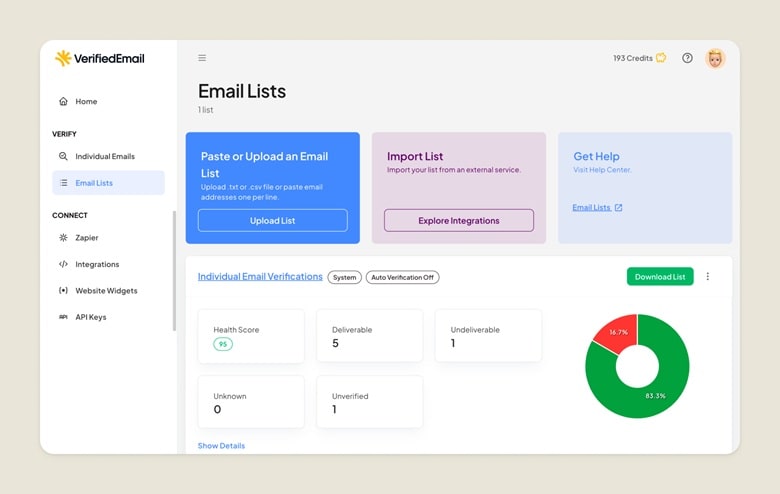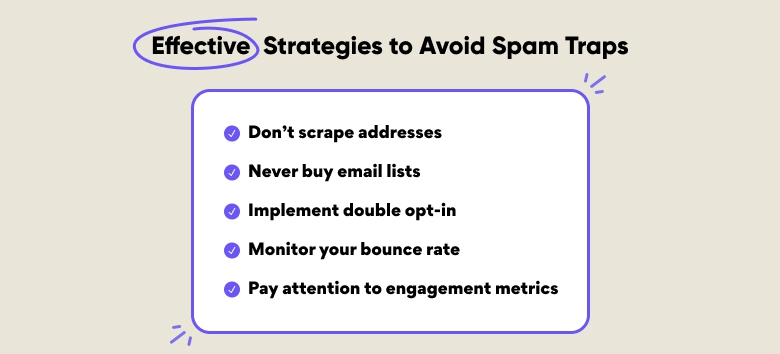Email Verification Best Practices For 2025
Email verification best practices aren’t just a nice-to-have — they're the backbone of delivering messages and reaching your intended target audience. Whether refining your outreach strategy or safeguarding your sender reputation, now is the time to rethink how you verify emails and connect.
Importance of Email Verification
Email verification is the linchpin of effective and efficient communication. With it, your marketing campaigns can be protected from invalid addresses, bounces, and spam bots that clog your list. Verifying emails keeps your contact lists healthy, ensuring your messages land in the right inboxes and are seen by real people.
The payoff? Better accuracy for personalized outreach, good open rates, and improved engagement. Verifying email addresses can increase deliverability and decrease bounces, helping your messages bypass those pesky filters.
Verification also helps protect your reputation. When you send messages to invalid or inactive addresses, it signals to internet service providers (ISPs) that you may be sending unsolicited or irrelevant content. This could result in your emails being flagged as spam and damaging your sender reputation.
It’s simple math — a clean contact list equals better outcomes.
Email Verification Best Practice
To keep your marketing strategy sharp in 2025, consistency and rigor in email verification are absolute non-negotiables. Here are the best practices for email verification every marketer and business should adopt:
1. Validate Emails in Real-Time
The best way to verify email address? Integrate real-time email validation tools at sign-up or checkout. Email validation can cross-check entries immediately, rejecting fake or mistyped addresses before they infiltrate your database.
And as far as email validation best practices are concerned — consider implementing CAPTCHA, regular list cleaning, tracking engagement metrics, and avoiding purchased lists.
Of course, the best way to validate email addresses is a combination of all these things.
2. Consider Third-Party Verification Services
Outsourcing email verification to a trusted provider can save you time and ensure expert handling of your email list. For instance, VerifiedEmail offers advanced multi-layer verification, rapid real-time processing, and seamless integration with your existing systems—all while maintaining robust security standards.

Using a service like VerifiedEmail not only improves deliverability and reduces bounce rates, but also allows you to focus on your core business without the hassle of managing complex in-house verification processes.
With flexible pricing and a user-friendly platform, VerifiedEmail is an excellent choice for marketers looking to maintain a clean, compliant, and high-performing email database
3. Run Regular Bulk Email List Cleanups
Despite solid upfront validation, lists can degrade over time as addresses become obsolete. Scheduling routine cleaning ensures your database stays lean and accurate. Use reliable software to identify invalid, inactive, or duplicate emails.
4. Segment and Monitor Your Database
Divide your audience into active and inactive users. Monitoring engagement rates can help identify disengaged users who might damage your deliverability scores. Actively prune or re-engage these contacts.
5. Use Double Opt-In Methods
Double opt-in requires users to confirm subscriptions by verifying their emails. This step ensures that only legitimate, interested users make it onto your list.
6. Stay Compliant with Privacy Regulations
Adhere to laws like GDPR and CAN-SPAM to ensure transparency when collecting and verifying email addresses. These standards protect users and help maintain trust with your audience.
7. Track Engagement Metrics
Keep an eye on your bounce rates to identify potential issues with your contact list and address them promptly. Regularly analyze open rates, click-through rates, and other engagement metrics to identify and address issues with inactive or invalid emails.
8. Use Email Verification APIs
Integrate a robust verification API to automatically validate every email address as it’s submitted. For example, VerifiedEmail’s REST API delivers rapid, real-time checks with minimal latency, ensuring that only valid addresses enter your system.
VerifiedEmail’s API is designed with developers in mind—offering comprehensive documentation, easy integration with CRMs and sign-up forms, and support for common programming languages. This seamless integration reduces manual work, keeps your contact list clean and current, and ultimately improves your email deliverability.
9. Educate Your Team
Ensure your marketing and sales teams understand the importance of verification and are trained to use the tools effectively.
Challenges and Solutions in Email Verification
While verification offers significant benefits, it can be challenging. Here’s how to address the most common challenges in verifying emails:
High Bounce Rates
Challenge: Mistyped or fake addresses inflate bounce rates, harming your sender reputation.
Solution: Use intelligent validation tools to block or flag invalid entries before they reach your list.
Overcoming Language and Regional Data Barriers
Challenge: Different formatting conventions across regions can lead to validation errors.
Solution: Opt for global verification tools recognizing diverse email patterns and applying localization best practices.
Avoiding Spam Traps
Challenge: Spam traps can blacklist you, damaging deliverability.
Solution: Regularly clean your list and avoid purchasing third-party contact lists. Focus on organic growth.

Managing Resource Costs
Challenge: High-quality tools and regular cleanups are expensive.
Solution: Calculate the ROI of investing in effective verification tools. Compare it against the cost of missed conversion opportunities or a damaged sender reputation.
Conclusion
Your email campaigns are only as good as the data driving them. Make email verification a non-negotiable part of your strategy to ensure your messages reach the right people, your reputation stays intact, and your results exceed expectations. Implementing these best practices might take effort, but the benefits — higher engagement, better deliverability, and a healthier bottom line — are well worth it.
Verified emails aren't just about crossing something off a checklist; it’s the foundation of building meaningful connections at scale.
Verify 200 emails for free. For lists over one-million emails, we will beat the price of any competitor, guaranteed.

